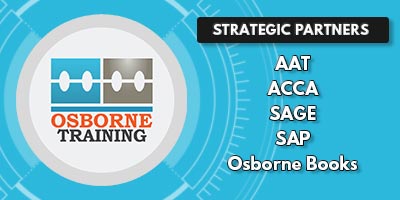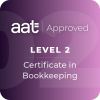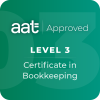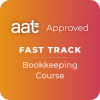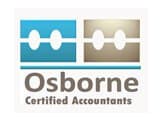
What is AAT Level 4 Accounting?
Are you looking to advance your career in accounting? Are you ready to take your accounting career to the next level? If so, studying AAT Accounting level 4 qualification could be the next step for your career.
What is it?
AAT Accounting Level 4 is the highest level of the Association of Accounting Technicians (AAT) qualification. This level covers a wide range of topics. This qualification will help you to handle complex financial tasks confidently.
This qualification is designed for the individuals who have already completed AAT Accounting Level 3 qualification or have the relevant work experience in accounting and finance field.
What is it equivalent to?
AAT Accounting Level 4 qualification is equivalent to a higher diploma or the first year of a bachelor’s degree.
It is also comparable to HNC qualification.
Entry Requirements
Association of Accounting Technicians aka AAT does not set any entry requirements for this qualification but for the better understanding, individuals must typically meet some requirements such as completion of AAT Accounting Level 3, basic understanding of accounting principles, numeric skills and much more.
It is recommended by AAT for students to use AAT Skillcheck to ensure that they are ready to start on a particular level. Find the link below.
https://www.aat.org.uk/qualifications-and-courses/skillcheck
Who is this suitable for?
AAT Accounting Level 4 is designed for the individuals who have completed the AAT Accounting Level 3 qualification or equivalent. It is suitable for anyone who has a career in accounting and finance and are looking to advance their career.
About the AAT Accounting Level 4
| Qualification name | AAT Level 4 Diploma in Professional Accounting |
| Qualification number | 603/6339/3 |
| Level | 4 |
| Guided learning hours (GLH) | 390 |
| Total qualification time (TQT) | 985, 1022 or 1059 (depending on completed options) |
Course Structure
AAT Accounting Level 4 typically consists of 3 mandatory units and 2 optional units.
Mandatory Units
The mandatory units include:
- Applied Management Accounting Techniques
- Internal Accounting Techniques
- Drafting and Interpreting Financial Statements
Optional Units
The optional units include:
- Business Tax
- Personal Tax
- Audit and Assurance
- Cash and Financial Management
- Credit and Debt Management
- Applied Management Accounting
This is a mandatory unit in AAT Accounting Level 4.
| Unit level | GLH value | Unit reference number | Assessment |
| 4 | 120 | F/618/3591 | Unit assessment |
- Drafting And Interpreting Financial Statements
This is a mandatory unit for in Accounting Level 4
| Unit level | GLH value | Unit reference number | Assessment |
| 4 | 90 | L/618/3593 | Unit assessment |
- Internal Accounting Systems and Controls
This is a mandatory unit in AAT Accounting Level 4
| Unit level | GLH value | Unit reference number | Assessment |
| 4 | 60 | R/618/3594 | Unit assessment |
- Business Tax
This is an optional unit in AAT Accounting Level 4
| Unit level | GLH value | Unit reference number | Assessment |
| 4 | 60 | Y/618/3595 | Unit assessment |
- Personal Tax
This is an optional unit in AAT Accounting Level 4
| Unit level | GLH value | Unit reference number | Assessment |
| 4 | 60 | D/618/3596 | Unit assessment |
- Audit and Assurance
This is an optional unit in AAT Accounting Level 4
| Unit level | GLH value | Unit reference number | Assessment |
| 4 | 60 | H/618/3597 | Unit assessment |
- Cash and Financial Management
This is an optional unit in AAT Accounting Level 4
| Unit level | GLH value | Unit reference number | Assessment |
| 4 | 60 | K/618/3598 | Unit assessment |
- Credit and Debt Management
This is an optional unit in AAT Accounting Level 4
| Unit level | GLH value | Unit reference number | Assessment |
| 4 | 60 | M/618/3599 | Unit assessment |
Exam Structure
AAT Accounting Level 4 qualification consists of 5 units assessments in total, in which 3 are mandatory and 2 are optional. The students can choose 2 optional units out of 5 units.
- Applied Management Accounting Assessment and Marking Structure
| Assessment method | Marking type | Duration of assessment |
| Computer-based assessment | Partially computer/ partially human marked | 3 hours |
| Learning outcomes | Weighting |
| 1. Understand and implement the organisational planning process | 25% |
| 2. Use internal processes to enhance operational control | 27% |
| 3. Use techniques to aid short-term and long-term decision making | 25% |
| 4. Analyse and report on business performance | 23% |
| Total | 100% |
- Drafting And Interpreting Financial Statements Assessment and Marking Structure
| Assessment method | Marking type | Duration of assessment |
| Computer based assessment | Partially computer/ partially human marked | 2 hours 30 minutes |
| Learning outcomes | Weighting |
| 1. Understand the reporting frameworks that underpin financial reporting | 7% |
| 2. Draft statutory financial statements for limited companies | 43% |
| 3. Draft consolidated financial statements | 25% |
| 4. Interpret financial statements using ratio analysis | 25% |
| Total | 100% |
- Internal Accounting Systems and Controls
| Assessment method | Marking type | Duration of assessment |
| Computer based assessment | Partially computer/ partially human marked | 2 hours 30 minutes |
| Learning outcomes | Weighting |
| 1. Understand the role and responsibilities of the accounting function within an organisation | 10% |
| 2. Evaluate internal control systems | 25% |
| 3. Evaluate an organisation’s accounting system and underpinning procedures | 25% |
| 4. Understand the impact of technology on accounting systems | 15% |
| 5. Recommend improvements to an organisation’s accounting system | 25% |
| Total | 100% |
- Business Tax Assessment and Marking Structure
| Assessment method | Marking type | Duration of assessment |
| Computer based assessment | Partially computer/ partially human marked | 2 hours 30 minutes |
| Learning outcomes | Weighting |
| 1. Prepare tax computations for sole traders and partnerships | 19% |
| 2. Prepare tax computations for limited companies | 19% |
| 3. Prepare tax computations for the sale of capital assets by limited companies | 17% |
| 4. Understand administrative requirements of the UK’s tax regime | 15% |
| 5. Understand the tax implications of business disposals | 10% |
| 6. Understand tax reliefs, tax planning opportunities and agent’s responsibilities in reporting taxation to HM Revenue & Customs | 20% |
| Total | 100% |
- Personal Tax Assessment and Marking Structure
| Assessment method | Marking type | Duration of assessment |
| Computer based assessment | Partially computer/ partially human marked | 2 hours 30 minutes (FA23) |
| Learning outcomes | Weighting |
| 1. Understand principles and rules that underpin taxation systems | 10% |
| 2. Calculate UK taxpayers’ total income | 24% |
| 3. Calculate income tax and National Insurance contributions payable by UK taxpayers | 28% |
| 4. Calculate capital gains tax payable by UK taxpayers | 28% |
| 5. Understand the principles of inheritance tax | 10% |
| Total | 100% |
- Audit and Assurance
| Assessment method | Marking type | Duration of assessment |
| Computer based assessment | Partially computer/ partially human marked | 2 hours 30 minutes |
| Learning outcomes | Weighting |
| 1. Demonstrate an understanding of the audit and assurance framework | 10% |
| 2. Demonstrate the importance of professional ethics | 15% |
| 3. Evaluate the planning process for audit and assurance | 25% |
| 4. Evaluate procedures for obtaining sufficient and appropriate evidence | 35% |
| 5. Review and report findings | 15% |
| Total | 100% |
- Cash and Financial Management
| Assessment method | Marking type | Duration of assessment |
| Computer based assessment | Partially computer/ partially human marked | 2 hours |
| Learning outcomes | Weighting |
| 1. Prepare forecasts for cash receipts and payments | 15% |
| 2. Prepare cash budgets and monitor cash flows | 25% |
| 3. Understand the importance of managing finance and liquidity | 15% |
|
20% |
| 4. Understand regulations and organisational policies that influence decisions in managing cash and finance | 25% |
| Total | 100% |
- Credit and Debt Management
| Assessment method | Marking type | Duration of assessment |
| Computer based assessment | Partially computer/ partially human marked | 2 hours |
| Learning outcomes | Weighting |
| 1. Understand relevant legislation and contract law that impacts the credit control environment | 15% |
| 2. Understand how information is used to assess credit risk and grant credit in compliance with organisational policies and procedures | 45% |
| 3. Understand the organisation’s credit control processes for managing and collecting debts | 25% |
| 4. Understand different techniques available to collect debts | 15% |
| Total | 100% |
How the overall grade is determined
Students will be awarded an overall qualification grade (Distinction, Merit, and Pass).
Students who do not achieve the qualification will not receive a qualification certificate and will be shown as unclassified. This is indicated below for illustrative purposes only.
The raw marks of each assessment will be converted into a percentage mark and rounded up or down to the nearest whole number. For example, 75.5% would be rounded up to 76%, whereas 82.1% would be rounded down to 82%. This percentage mark is then weighted according to the weighting of the unit assessment within the qualification. The resulting weighted assessment percentages are combined to arrive at a percentage mark for the whole qualification
| Grade definition | Percentage threshold |
| Distinction | 90–100% |
| Merit | 80–89% |
| Pass | 70–79% |
| Unclassified | 0–69% Or failure to pass one or more assessment/s |
| Example of Pass Assessment | Contribution of assessment to qualification grade | Percentage achieved | Weighted percentage contribution to grade |
| Applied Management Accounting | 30% | 78% | 23.4% |
| Drafting and Interpreting Financial Statements | 20% | 85% | 17% |
| Internal Accounting Systems and Controls | 20% | 72% | 14.4% |
| Business Tax | 15% | 81% | 12.2% |
| Personal Tax | 15% | 72% | 10.8% |
| Total | 78%* | ||
This has been rounded to the whole number
| Example of Merit Assessment | Contribution of assessment to qualification grade | Percentage achieved | Weighted percentage contribution to grade |
| Applied Management Accounting | 30% | 81% | 24.3% |
| Drafting and Interpreting Financial Statements | 20% | 86% | 17.2% |
| Internal Accounting Systems and Controls | 20% | 87% | 17.4% |
| Personal Tax | 15% | 82% | 12.3% |
| Credit and Debt Management | 15% | 79% | 11.6% |
| Total | 83%* | ||
This has been rounded to the whole number
| Example of Distinction Assessment | Contribution of assessment to qualification grade | Percentage achieved | Weighted percentage contribution to grade |
| Applied Management Accounting | 30% | 91% | 27.3% |
| Drafting and Interpreting Financial Statements | 20% | 92% | 18.4% |
| Internal Accounting Systems and Controls | 20% | 89% | 17.8% |
| Audit and Assurance | 15% | 94% | 14.1% |
| Cash and Financial Management | 15% | 86% | 12.9% |
| Total | 91%* | ||
This has been rounded to the whole number
AAT qualification support
Throughout the life of this qualification, AAT will make available a range of free materials and resources to support tutors and students in delivery and assessment.
Materials produced for this qualification will include:
- practice assessments for each unit
- one Sample Assessment and Mark Scheme (Introduction to Bookkeeping)
- Qualification Technical Information (QTI)
- annual Chief Examiner reports.
Additional materials may also include:
- e-learning
- Green Light tests
- webinars
- tutor-to-tutor sessions at network meetings.
All AAT study support resources can be accessed via the AAT Lifelong Learning Portal.
What can you do after AAT Accounting Level 4
After completing AAT Accounting Level 4, individuals have gained a comprehensive knowledge of advance accounting. With this knowledge and skills, individual can pursue a variety of careers in accounting and finance field. Some of the examples are given below:
- Assistant Accountant
- Tax Accountant
- Management Accountant
- Auditor and much more
Additionally, students can pursue higher studies such as Association of Charted Certified Accountants (ACCA) or Chartered Institude of Management Accounting (CIMA) to enhance their career prospects.
Conclusion
In conclusion, completing AAT Accounting Level 4 qualification demonstrate a high level of knowledge and competence in the field of accounting and finance. This qualification provides individuals with the skills and confidence to pursue a successful career in the accounting and finance field.
Overall, AAT Accounting Level 4 is a valuable qualification that can open up a wide range of opportunities and career options in the accounting and finance profession.
